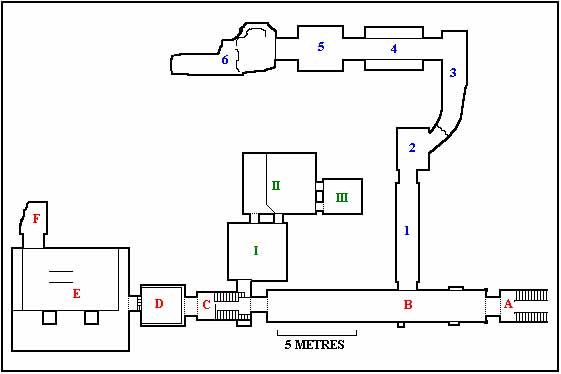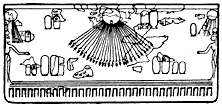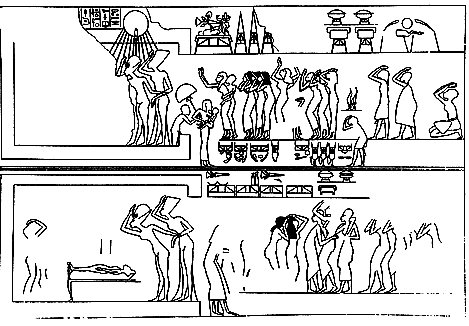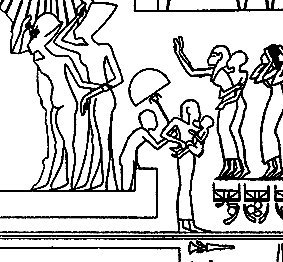|
|
|
|
|
|
Hidden among the hills that border the abandoned city of Akhetaten is the tomb of its King. In death as in life, Akhenaten refused to be conventional - the only king of the 18th Dynasty not to be buried in the Valley of the Kings, family type themes for the reliefs in the tomb itself, an alignment with the morning sun (so that the spirit would rise each day with the sun) and a design of tomb that was unique in ancient Egypt.
The Tomb's design.

Most of the 'main' part of the tomb (the original design) is a long straight corridor, descending by two staircases (A and C) delving 28 metres into the hillside before ending in the anteroom D which itself leads onto the burial hall.
A - The Anteroom and the Protective Well.
Separating the anteroom and the burial hall is the protective well (a depth of 3.5 metres), the 'well' room was once decorated with reliefs on the wall which included figures of the King and Queen offering to the Aten and of the elder princesses on the end walls.
B - The Burial Hall.
After Akhenaten's burial the doorway to this room was sealed with limestone blocks (later tomb robbers used these same limestone blocks to fill the Protective Well.
The Burial Hall itself is a large 10 metres square and 3.5 metres high with a small platform on the left side of the room - 33cm high, which supported the remains of two square piers. The builders of the tomb had started to cut another doorway (F) but did not get very far before it was abandoned.
The reliefs in the Burial Hall were almost completely destroyed and very little is left to be examined , but titles of Akhenaten, Nefertiti and the Aten can just be made out near the line of the ceiling.
|
|
 |
|
|
|
Research carried out by Professor Martin at the Royal tomb has given good evidence that Akhenaten was buried in a pink granite sarcophagus - although both this and the remains of another sarcophagus found at the tomb, were smashed to pieces and then scattered over some distance. However enough of Akhenaten's sarcophagus has been recovered to reconstruct it, the corners had figures of Queen Nefertiti extending protective arms like the guardian of the four quarters.
 |
|
Up to this point the Royal Tomb of Akhenaten was very similar to a 'standard' tomb found in the Valley of the Kings - a straight forward design of corridors and rooms along a single axis, but this tomb was to change with the addition of two more separate suites of rooms:
The Upper Group
(rooms 1-6)
The layout of these rooms is actually the same as the 'main tomb' - three corridors or passages (1,2,3) which eventually lead into three rooms (4,5,6) which are in a much rough and unfinished state. On the left-hand wall in room 1 a doorway had been tentatively cut possibly as the entrance to yet another suite of rooms but this was as far as the cutting ever proceeded.
The Middle Group
(rooms I to III)
Since their discovery by the French these rooms have been known as Alpha (I), Beta (II) and Gamma (III) - of which chambers I and III have walls and ceilings carved with reliefs, although both are now severly damaged.
Chamber I
(5.5 metres square, 3 metres high)
The reliefs in this room were originally carved rather crudely into the very hard rock, but were then covered with plaster, modelled to a much finer degree and then painted (the plaster has, unfortunately, fallen away although the odd trace of colour does still survive).
The two main scenes were of the royal family, (Akhenaten, Nefertiti and their 5 daughters) making offerings to the Aten (dawning on the East wall, and setting on the West wall) in a temple court.
|
Limestone relief found in Room 4, the design shows the king and queen making offerings before altars heaped with flowers. The two eldest daughters are also present shaking sistrums. (The style is characteristic of the early style from Akhenaten's reign). |
|
Scenes on the walls with the doorways show reliefs of charioteers in attendance with worshippers waiting outside the temple gates along with a military escort.
Perhaps the most important scene in this room shows the King and Queen mourning the death of a woman, queen or princess.

The scene is made up of two panels:-
In the upper panel the Aten is present, but in the lower the Aten is absent which is suggested as meaning a night vigil. Outside the room various mourners are pouring sand on their heads, wailing to the sky and so on. Most importantly is the depiction of a baby being held by a nursemaid - the baby is known to of been or royal rank by the presence of a fan-bearer.

The Mysterious child
The identity of this baby is unkown - although the most favoured guess is that the woman on the bier is Maketaten who must of died in childbirth and therefore that the baby is her surviving child.
The problem is that the hieroglyphs that revealed the identity of these people have been destroyed in antiquity and so anything is guesswork - indeed, recently the assumption that the woman must be Maketaten has been challenged, the body could be another royal daughter or even a minor queen of Akhenaten.
Which leads onto another important development that this tomb brings - the entrance of Queen Kiya. Kiya was a minor queen of Akhenaten, I reprint here an excerpt from Julia Swanson's book 'Nefertiti and Cleopatra':
"In one picture, a woman is shown behind Akhenaten and Nefertiti carrying away a child sitting in her arms. It has been suggested that this might be Maketaten's baby fathered by Akhenaten and that she died in childbirth. There is no evidence for this. Who was this child and what happened to it? It could in fact have been a younger brother or sister of Maketaten's born to Kiya. Another suggestion was that Meritaten as the official "Heiress", might have had a child by her father with the object of keeping the royal succession in the legitimate line, and that she, too, at her death, might have been buried in this tomb: no evidence remains however. These children could have been Kiya's children by Akhenaten. Certainly Ankhesenpaaten was too young to have borne Tutankhamun. Was he not Kiya's son? And was this the reason, as has been suggested, why her name was denied her and overcarved by Meritaten's to register, as it were, an apparently 'legitimate' succession? The art in the royal tomb, although revised in some places, appears in the main to be that of the middle period of the reign, which accords with the 'trio' as described on the Hermopolis blocks - the figures of a crowned king with an uncrowned woman, and a child - who could well be Ankhenaten, Kiya and their child."
(Julia Samson)
It is also in this chamber that four niches had been cut into the walls to receive 'magic bricks', these were made from unbaked clay, carried differing amulets and were inscribed with spells from chapter 151 from the 'Book of the Dead' which were meant to protect the deceased from intruders.
Chamber III
Roughly 3.5 metres square (with side elongated to metres however), 1.8 metres high, and meant as a burial chamber - one of the walls was decorated with pictures of funerary furniture, but the main feature is another deathbed scene similar to the scene in room Alpha (I). Once again the dead princess/queen lies on her deathbed, however her figure and name have been erased. Her parents/king and queen are seen weeping at her side and outside a nurse is once more holding a baby followed by two fan bearers - the mainstream theory is that another princess also died in childbirth.
The companion scene on the opposite wall shows the king and queen, the four surviving princesses and other mourners all pouring sand over their heads (the dead princess stands before them to receive the last farewells.). But in this scene the text identifies the deceased as Princess Maketaten. Crucially the text referring to the nurse and the infant has been completely destroyed, most probably anciently.

